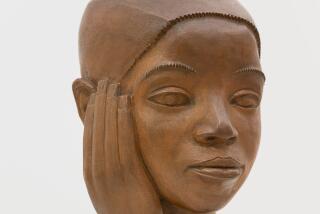The Power of Art
Christopher Knight joins an ignoble line of cynics and curmudgeons who denigrate the value of the arts whenever tough national issues emerge or budgets tighten (“What Exactly Can Art Heal?,” Nov. 4). He strangely asserts that “faith in art’s capacity to heal is peculiar.”
Rather, the power of the arts to heal is intrinsic. One has only to have heard the voice of Denyce Graves during the National Cathedral memorial service to see how the arts can heal. Or to have seen the crayon drawings and pictures sent to New York City families and rescue workers to witness their therapeutic effect.
Throughout California and the country, local concerts, murals, remembrance projects and community art projects have helped Americans deal with the unthinkable, to take pride in their country, and to foster tolerance and understanding.
What’s his beef? That politicians embrace this concept is to their credit and, if anything, signifies progress, not the “old-timey.” Saul Bellow wrote: “Art attempts to find in the universe, in matter as well as in the facts of life, what is fundamental, enduring, essential.” In these shaky times, we help ourselves by supporting and participating in the arts.
JOEL L. FLATOW
West Hollywood
*
Let me get this straight. Arts organizations, sending out art-positive material during National Arts and Humanities Month, are somehow guilty of war profiteering? That seems to be Christopher Knight’s conclusion.
The “economic stimulus package” that just passed the House--thanks to intense lobbying efforts on the part of huge business interests--will result in billions of dollars in tax rebates and long-term tax cuts to multibillion-dollar entities like General Electric. That is war profiteering.
For Knight to focus his ire on the relatively impoverished fine art community is, to say the least, misguided.
RICO GAGLIANO
Los Angeles
*
In the main, I agree with Knight’s argument that art is not meant as a tool for curing the ailing psyche.
When I was studying for my degree in psychology, I was interested in something called “poetry therapy.” I went to a reading of poet John Thomas and mentioned that subject. He looked astonished and almost laughed in my face.
Since then, as a poet and novelist (and psychotherapist), I have given the matter a good deal of thought. While I do believe the act of creating a work of art can bring the creator a transcendent experience, in and of itself I don’t see its ability to heal trauma.
In times of extreme stress, of fear, insecurity, we would love to have a safe harbor, but surely art doesn’t provide that. Alas, our political institutions can’t make art a substitute for their deficiencies.
PEGGY AYLSWORTH LEVINE
Santa Monica
*
The truly infuriating thing about Knight’s article is not the argument he makes, but the one he presumes. Knight dismisses the healing power of art as “insupportable” and “a political fiction” without explaining how or why he believes this. Yet most lovers of the arts take their personal experience as proof enough that art can heal.
If an artist can capture a few of the moments life presents to us all the time--a moment of honest humanity, a touching moment, a funny moment, an observation--or can even invent a few, then he or she has in some sense gained control of life. The artist has understood life enough to replicate it, and therefore we are not at its mercy, if only for that moment.
COLIN DOTY
Los Angeles
*
Last week I led a discussion with my son’s fourth-fifth grade class on how art can make a difference. We talked about the Vietnam memorial and the AIDS quilt. I told them about the AIDS project I did last year in Zimbabwe--a country where the graveyards are full, yet people claim their relatives are dying of something else. In collaboration with artists from a ceramics factory, funded in part by a Fulbright grant, we built a wall depicting how AIDS has affected their community. Located in the National Gallery Sculpture Garden in Harare, it includes a tile bench made by children orphaned by AIDS.
In his stingingly negative article, Knight states, “You’d probably do just as well investing in crystals or soliciting the psychic services of Miss Cleo.” The AIDS wall was built in part to contradict the “Miss Cleos” of Africa, some of whom advise the best cure for AIDS is to have sex with a virgin, particularly a child. Although I decided to forgo that fact with the fourth-and fifth-graders, they clearly understood that art can make a difference.
Too bad that concept is lost on Knight.
JOYCE KOHL
Altadena
More to Read
The biggest entertainment stories
Get our big stories about Hollywood, film, television, music, arts, culture and more right in your inbox as soon as they publish.
You may occasionally receive promotional content from the Los Angeles Times.










